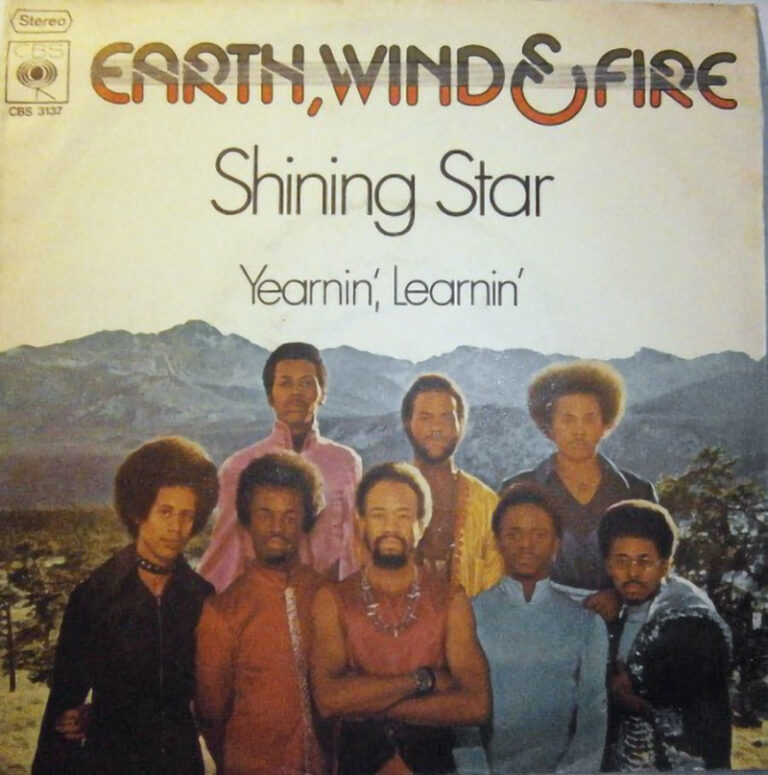4

Shining Star - Earth, Wind and Fire

B-Side: Yearnin’ Learnin
From the Album: That’s the Way of the World
Released: January 21, 1975
Recorded: Autumn 1974
Studio: –
Genre: Progressive soul, funk
Length: 2:50
Label: Columbia (Columbia 10090)
Songwriter(s): Maurice WhiteLarry, DunnPhilip Bailey
Producer(s): Maurice White, Charles Stepney
Earth, Wind and Fire was formed late in 1970 by a Chicago session musician who had worked for Motown, Chess, and several Windy City stars. Maurice White conceived his group one night on paper, while sitting alone at his kitchen table. He’d been reading a book entitled The Laws of Success and felt inspired to put together a band “with a dynamic name and new musical message.” He outlined the kind of group he wanted to form and even drew pictures of the way he wanted them to look (later, the members did resemble those early sketches). He then thought about a name, “Fire,” but rejected it as not comprehensive enough to describe his dream band. Turning to an astrological chart, he discovered that air and earth were elements of his birth sign, Sagittarius. By substituting the word wind for air, he devised “the perfect name” for his group.
Earth, Wind and Fire began as a straight jazz band, cutting a couple of flop albums for Warner Brothers. After being dumped by the label in 1971, Maurice fired most of his players and regrouped. A third album, issued by Columbia, did even worse in 1972 — selling fewer than fifty thousand copies. Desperate, Maurice took his band on the road, touring mostly black middle-class college towns. He experimented with the group sound and made careful note of audience reaction to his ideas. Slowly, their style began to evolve, with less emphasis on jazz and more on basic R&B. Maurice simplified Earth, Wind and Fire, borrowing concepts from War, Santana, the Ohio Players, and Sly and the Family Stone. Costumes, sets, and stunts were added to their live show, turning them into one of the most theatrical of all black groups. Record sales began to climb, until finally Earth, Wind and Fire was outselling every other act on the Columbia roster, except Chicago.
Their sixth album, That’s The Way of the World, released in February 1975, was the soundtrack from a movie of the same name, about a record company executive who tries to promote a new group. The band in the film was played by members of Earth, Wind and Fire.
“In our efforts to communicate,” wrote Maurice in the liner notes, “we’ve set a new goal in the presentation of this album. This is a musical score, put together with you in mind. Each song is an event relative to an experience we’ve lived while trying to achieve perfection in our everyday lives. We laugh, we cry, we worship, we enjoy. You might recall an old saying: ‘You reap what you sow.’ That’s the way of the world.”
“Shining Star” was the first song on side one of the album. It related to the group’s belief that everyone has the potential to become a star in his or her own way. Amid lusty instrumental backing, it spoke a new kind of philosophical gospel. The single was released in March 1975 and immediately took off as a heavily played disco record. By May, it was number one on the pop charts, and on June 19, it received gold certification from the RIAA. Months later, when the Grammies were passed out, “Shining Star” earned the award for Best R&B Performance by a Vocal Group.
“Shining Star” kicked off a long string of pop hits for Earth, Wind and Fire, including “Sing a Song,” “Getaway,” “Serpentine Fire,” and “Got to Get You into My Life” (the Beatles song sung by them in the 1978 movie Sgt. Pepper’s Lonely Hearts Club Band). Another hit was the title track from the album That’s The Way of the World.
“Shining Star,” like nearly all Earth, Wind and Fire material, was built around simple R&B percussion. The same could by said about many disco records in the seventies, yet “Shining Star” was different — it was lyrically strong as well.
Earth, Wind and Fire enjoyed a good, clean image in the seventies; most of the members were vegetarians, and none smoked, drank, or took drugs. They gathered regularly to meditate and achieve “oneness of mind” before performing. Maurice White summed up their attitude in this way: “We live in a negative society. Most people can’t see beauty and love. I see our music as medicine.”





